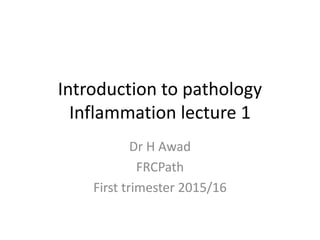
Introduction to pathology.pptx
- 1. Introduction to pathology Inflammation lecture 1 Dr H Awad FRCPath First trimester 2015/16
- 2. inflammation
- 3. Inflammation Definition • Protective response • involving (1)host cells, (2)blood vessels and (3)chemical mediators , • intended to • (1)eliminate (a)the initial cause of injury and the (b)necrotic tissue resulting from the insult • (2)initiate repair.
- 4. Unintended outcomes! • Inflammation is a protective mechanism….. Not a disease • However… cells and mediators that destroy injurious agents can destroy normal tissue.
- 5. Signs of inflammation • Calor ……. hotness • Rubor …….. redness • Tumor…….. swelling • Dolor……… pain • Functio laesa.. Loss of function
- 7. Causes of inflammation any cause of cell injury • Infections • Trauma • Physical : thermal injury, burns • Chemicals • Tissue necrosis: ischemia or physical insult • Foreign bodies • Immune reaction
- 8. Infection versus inflammation • What are the differences????
- 9. Acute versus chronic • Acute: rapid onset, short duration, fluid and plasma protein exudation, predominantly neutrophils. • Chronic: insidious onset, longer duration ( days to years), lymphocytes and macrophages, vascular proliferation and fibrosis.
- 10. Acute versus chronic inflammation feature acute chronic onset Fast: Minutes to hours Slow: days cells neutrophils Lymphocytes & macrophages Tissue injury and fibrosis Mild and self limited Severe, progressive Local and systemic signs prominent May be subtle
- 11. mechanisms • So.. Cells and molecules needed for the inflammatory response. • These are present in the blood. • The goal of the inflammatory reaction is to bring these cells and mediators to the site of injury.
- 12. Chemical mediators • Secreted from inflammatory and host cells (e:g cytokines) • Derived from plasma proteins (complement)
- 13. Self control • Inflammation is controlled and self limited. • Inflammatory cells are short lived, and degraded or become inactive. • Anti inflammatory mediators.
- 14. Recognition of injurious agent • Receptors on several cells recognize injurious agents. • These receptors present on macrophages, dendritic cells , epithelial cells and others. • These receptors are called pattern recognition receptors because they recognize structures common to many microbes or dead cells.
- 15. Pattern recognition receptors Two families: • Toll like receptors. • inflammasomes
- 17. Toll like receptors • Microbial sensors. • 10 mammalian types: • Can recognize bacterial products : endotoxins or DNA. • Can recognize viral products: RNA
- 18. Toll like receptors • Located on plasma membrane and endosomes. • So: can recognize extracellular and ingested microbes.
- 19. Toll like receptors • Once they recognize the microbe… transcription factors activation… which stimulate production of chemical agents (inflammatory mediators)
- 21. Inflammasome • Multi-protein cytoplasmic complex. • Recognizes products of dead cells… uric acid, extracellular ATP, crystals, some microbes.. • When stimulated, inflammasome activates caspase 1. • Caspase 1.. Cleaves and thus activates IL- 1 which is a potent mediator.
- 22. Inflammasome in action 1)Gout Urate crystals deposited in joints.. Ingested by macrophages.. Activate inflammasome… IL 1 production… inflammation 2)Inflammasome stimulated by cholesterol crystals.. Possible role of inflammasome in atherosclerosis. 3) Also activated by free fatty acids in obese people… development of type 2 DM. ???TREATMENT BY blocking IL 1
- 23. gout
- 25. Acute inflammation Vascular changes: *vasodilation and increased vascular permeability. *endothelial cell activation to increase leukocyte adhesion and migration . Cellular events:
- 26. Vascular changes • 1)Transient vasoconstriction.. Seconds. • 2)Vasodilation… increased blood flow. • 3) Increased vascular permeability… extravascular edema • 4) loss of fluids from capillaries increases blood viscosity… slowing of circulation = stasis • 5) stasis.. Neutrophils accumulate at the epithelial side = margination (the first step in leukocyte activation)
- 27. Increased vascular permeability • Results in edema. • Edema caused by inflammation is usually an exudate • Transudate versus exudate???
- 28. exudate • Edema fluid caused usually by inflammation. • Fluid rich in protein, cell debris and leukocytes. • High specific gravity • Transudate… low protein, low cell debris, no cells…. Due to changes in hydrostatic or osmotic pressure….. Here only fluid is lost
- 29. Causes of increased vascular permeability in inflammation • Endothelial cell contraction.. Increasing the gaps through which fluid is lost • Endothelial injury.. Loss of the barrier that prevents fluid to go out of the vessels. • Increased transocytosis • Leakage from new blood vessels.
- 30. Endothelial cell contraction • Most common cause of increased permeability. • Rapid response due to histamine, bradykinin and leukotrienes. • Short lived. • A similar response occurs due to cytokines.. Changes to cytoskeleton increasing the gaps.. This is slower but more prolonged.
- 31. Endothelial injury • Damage due to severe injury.. E:g burns or infections. • Can start immediately but lasts for several hours or days till the vessel is thrombosed • If injury is mild effect (permeability increase) can be delayed but long lived. E:g in mild thermal injury or certain bacterial toxins
- 33. neovascularization • New blood vessels formed during repair. • Leaky till proliferation of endothelial cells matures adequately to form intracellular junctions.